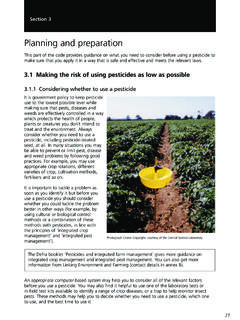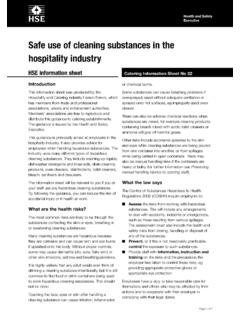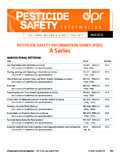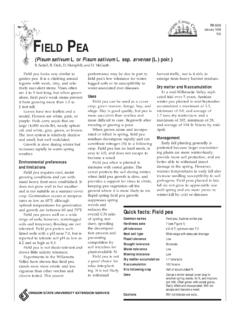Transcription of Septoria Leaf Spot of Tomato - Connecticut
1 Dr. Sharon M. Douglas Department of Plant Pathology and Ecology The Connecticut Agricultural Experiment Station 123 Huntington Street, P. O. Box 1106 New Haven, CT 06504 Phone: (203) 974-8601 Fax: (203) 974-8502 Founded in 1875 Email: Putting science to work for society Website: Septoria leaf SPOT OF Tomato Septoria leaf spot, also called Septoria blight, occurs throughout the United States and worldwide wherever tomatoes are grown. This disease can be quite destructive and crop losses of up to 100% have been reported in heavily defoliated fields. Septoria leaf spot is primarily a disease of Tomato , but it has been reported on other Solanaceous hosts including eggplant, potato, petunia, horsenettle, and black nightshade.
2 SYMPTOMS AND DISEASE DEVELOPMENT: Septoria leaf spot is caused by the fungus Septoria lycopersici. This fungus can attack tomatoes at any stage of development but symptoms usually first appear on the older, lower leaves and stems when plants are setting fruit. Symptoms commonly develop on leaves, but can occur on petioles, stems, and the calyx. The initial symptoms are small, water-soaked circular spots 1/16 to 1/8 in diameter on older leaves (Figure 1). The centers of these spots gradually turn gray to tan and have dark brown margins. The spots are distinctively circular and are often quite numerous. As the spots age, they sometimes enlarge and often coalesce (Figure 2). Figure 1. Diagnostic circular spots with tan centers and dark brown margins.
3 Figure 2. As the spots age, they enlarge and coalesce. The leaflets can quickly turn brown and shrivel. Septoria leaf spot is sometimes confused with bacterial spot of Tomato . These diseases can be differentiated using a diagnostic feature of Septoria leaf spot--the presence of many dark brown, pimple-like structures called pycnidia (fruiting bodies of the fungus) that are readily visible in the tan centers of the spots. When spots are numerous, affected leaves turn yellow and eventually shrivel up, brown, and drop off. Defoliation usually starts on the oldest leaves and can quickly spread progressively up the plant towards the new growth. This can occur in the transplant stage (Figure 3) or in the garden. Significant losses can result from early leaf -drop, which leads to sunscalding of the fruit when plants are prematurely defoliated.
4 Figure 3. Symptoms of Septoria leaf spot ontransplants. Note the progressive spread ofdisease from older to younger leaves. Septoria leaf spot is favored by warm, wet, humid conditions. Although the fungus can survive in or on seed and in weed hosts, the main source of inoculum is from leaf fragments and other plant debris from diseased plants that overwinter in the soil. This inoculum results from crumbled leaf fragments that fall to the soil (Figure 4). Figure 4. Infected leaves brown and shrivel. As the leaves crumble, leaf fragments fall to the ground. Individual spots are visible in the brown leaves. Under wet conditions, spores (also called conidia) of the fungus are produced in the pycnidia. Spore production is abundant when temperatures are between 60 -80 F. Spores are usually spread to healthy Tomato leaves by windblown water, splashing rain, and overhead irrigation.
5 However, spread can also occur on hands and clothing of pickers, cultivation equipment, and through the activities of several types of insects including Colorado potato beetles, flea beetles, Tomato worms, and aphids. After initial spread to healthy leaves, the spores germinate and infect the Tomato tissues. This occurs when free moisture is present on the leaves. Spots usually develop within 5 days after infection. The disease spreads as pycnidia develop in new spots, more spores are produced, and these spores infect more leaves. Septoria leaf Spot S. M. Douglas The Connecticut Agricultural Experiment Station ( ) 2 Septoria leaf Spot S. M. Douglas The Connecticut Agricultural Experiment Station ( ) 3 MANAGEMENT: The effects of Septoria leaf spot can be minimized through the combined use of culture, sanitation, and fungicide sprays.
6 It is very important to start each season pathogen-free by eliminating initial sources of inoculum. This involves removing or destroying as much of the Tomato debris as possible after harvest in the fall. Composting the debris is discouraged since the pathogen can survive in incomplete composts. Alternatively, in large fields where plant removal is not practical, plant debris can be covered and buried by deep plowing. These simple sanitary practices can significantly reduce disease development the following year since they remove key sources of the fungus that overwinter in the soil. During the growing season, it is important to start with healthy, disease-free transplants. If infected plants are found, rogue the seedlings before transplanting them into the field.
7 It is also helpful to practice a 3- to 4-year rotation with non-Solanaceous crops, if possible, and to control weeds in and around the garden. Since water is important to both the spread and development of Septoria leaf spot, it is helpful to avoid overhead watering or to water early in the day so that the leaves dry. With late afternoon or nighttime watering, the leaves stay wet longer and this provides optimum conditions for infection by the fungus. It is also helpful to avoid working with plants when they are wet, since the fungus can be spread during these types of activities. Staking and mulching can also help reduce infections. Staking increases air circulation and helps to dry the leaves this reduces favorable conditions for infection. Mulching acts as a barrier between the soil (containing infected fragments of plant debris) and the Tomato and prevents splashing of spores onto the lower leaves.
8 This is often the primary way the disease gets started each season. Although resistance to Septoria leaf spot has been tentatively identified in several lines of Tomato used for breeding, no cultivars with resistance are commercially available. The final strategy for managing Septoria leaf spot involves the proper selection, timing, and application of fungicide sprays. Fungicides are very effective and are often necessary to supplement the other management strategies previously outlined. Thorough coverage of all parts of the plant is necessary and the sprays should be applied until run-off. The fungicide label will contain information on dosage rates, pre-harvest interval (PHI), and safety precautions. Among the fungicides registered for homeowner use in Connecticut are chlorothalonil and mancozeb.
9 Organic options include fungicides containing copper, potassium bicarbonate, and QST 713 strain of Bacillus subtilis. Since most fungicides are protectant materials, they should be applied as soon as symptoms are observed and repeated as necessary when conditions are favorable for disease development and spread. In Connecticut , the first sprays are usually needed by mid-July, between flowering and first fruit set. June 2008 (revised)

















